Search this site ...
Contemporary African
Recycled art
Recycled art is one of the most dynamic forms of contemporary art in Africa.
Anywhere you go in Africa you will see trash... scattered on the sidewalks, piled in the markets, debris discarded in the rivers, plastic bottles floating in the oceans; in fact, most everywhere you look!
Recycled art is usually recognised as the employment of garbage and found items in the process of making art.
Junk art uses everyday, disposable items in new formats although the original item may not be changed.
Up-cycling functions to promote an idea, pointing to an issue through the utilization of discarded and found items... and by this method, value is added to the final creation.
Look at the buildings behind you and you will see crumbling walls in paint-flaking decline.
Have another glance and you may see street art, graffiti and architectural re-invention that will astonish you: Shelters are constructed from every kind of building material imaginable, patched together to make makeshift homes:
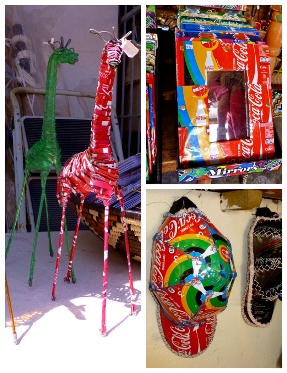 Soda can art, SA
Soda can art, SAAn old lady rests in the sun, sitting on her refurbished chair, random materials bound together; converted into something newly useful.
Step to the small, local gift shop on the corner, passing by a pile of rejected, everyday items... and you will see small wire, tin, paper or metal items all cleverly repurposed for the tourist trade: Animals, mirrors, cars, aeroplanes, toys, bags, jewelry - too many products to mention.
Re-invented crafts exist like woven baskets made from brightly colored telephone wire or metal interwoven strips... or pots that are not ceramic; perhaps they are constructed from handmade, dung paper or soft cardboard that is, actually, pulped strips of cotton fabric.
At the city museum or gallery, up-scaling is encountered.
Sophisticated pieces may still have a function but others have been created purely for aesthetics; as an art form... and they may have a social or political comment to make reflecting the artists's thoughts and ideas on a certain issue. You might find reconstructed masks on the wall, free-standing sculptures, wall art, photographs or collages all made from recycled junk material.
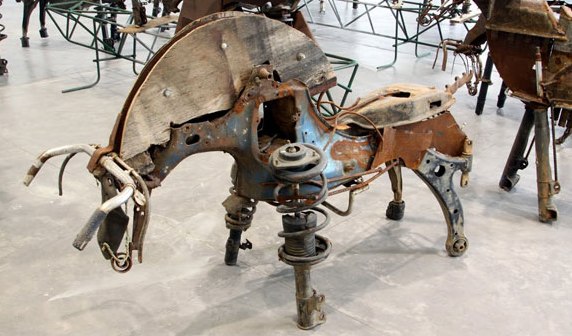 Ram, Olu Amoda, Nigeria
Ram, Olu Amoda, NigeriaIn a scrap yard the magnitude of shapes and materials can inspire - each form or object leads to another step in the process of making something new. The dimension of a selective process taking place immediately implies a thought already conspired.
Symbolic meaning is probably subconsciously attached to the choices, based on their own memories and relationships with the items, including how they make them feel. Therefore an upcycled piece can relate on very different levels to different people.
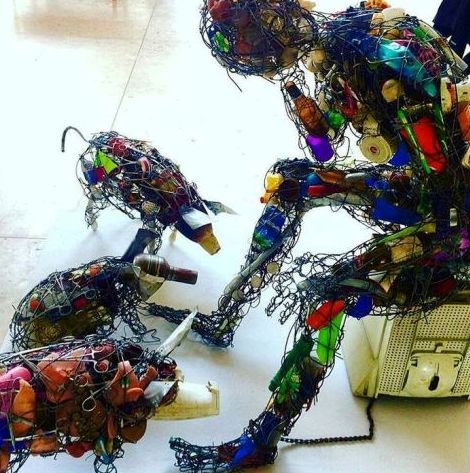 National Gallery, Zim recycled art
National Gallery, Zim recycled art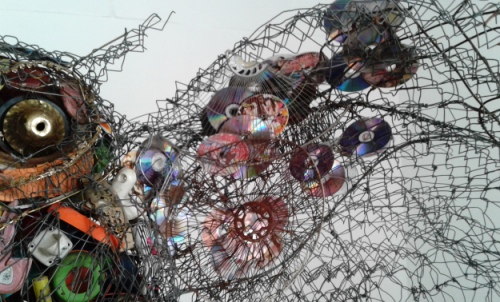 Owl, Johnson Zuze, Nat Gall, Zimbabwe
Owl, Johnson Zuze, Nat Gall, ZimbabweArrive in any major African city and your journey will undoubtedly take you past a vast, collective rubbish depo somewhere along the way. Humans will be seen dipping and scooping, collecting fragments and pieces of who-knows-what for some purpose visualised only to them.
Ships lie rusting in abandoned docks and cars pile up in dead-end alleys. But, before you, a monument rises up in the middle of a traffic circle or public park.
A huge, metal sculpture whose figurative outline is impressively realistic and recognizable in form... but certainly not in the type of materials used to meld it together.
Like the assembled figure seen above it can serve as an evocative testament and representation of days gone past, calling to its heritage while also transcending definition.
It has taken on its own form, a new identity... and it tells its own story.
On another dimension, photographers create images of wildly creative and deliberately re-invented things that are photomontaged together or put in surreal surroundings like large portraits of social conditions.
They convincingly convey the artists's message such as this visually powerful one below which has used computer parts and other scavenged items to good effect.
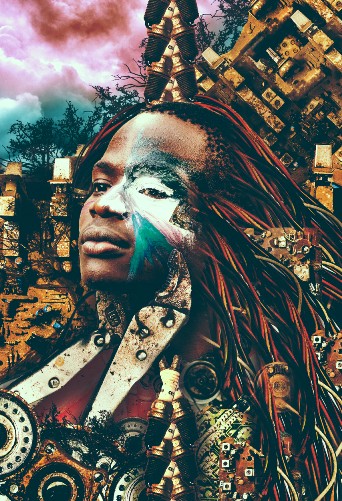 'Jua kali' series, Tahir Carl Karmali,
'Jua kali' series, Tahir Carl Karmali,This New York based artist pays tribute with this work to the informal workforce of his home country Kenya where full-time employment is rare and many people earn a living from their innovative endeavors.
ARTISTS
There a great number of artists on this continent, both established and emerging, who practice this form of art. There are many more than are listed below and given the nature of the genre - inherent, accessible, expressive, inexpensive to produce, saleable - there are sure to be many more.
- Amoda Olu, Nigeria b 1959
- Bester Willie, SA b 1956
- Botha Andries, South Africa b 1952
- El Anatsui, Ghana b 1944
- Dilomprizulike, Nigeria b 1960
- Adeagbo Georges, Benin b 1942
- Amidou Dossou, Benin b 1965
- Amoda Olu, Nigeria b 1959
- Bandoma Steve, Congo b 1981
- El Baz Mahomed, Morocco b 1967
- Clottey Serge Attukwei, Ghana b 1985
- Dias Jorge, Mozambique b 1972
- Dime Moustapha, Senegal 1952-1998
- Gaba Meshac, Benin b 1961
- Hazoume Romauld, Benin b 1962
- Kabiru Cyrus, Kenya b 1984
- Kader Attia, Algeria b 1970
- Karmali Tahir Carl, Kenya
- Mabota Titos, Mozambique b 1963
- Mabunda Goncalo, Mozambique b 1975
- Mahama Ibrahim, Ghana b 1987
- Mulondo Patrick, Uganda b 1989
- Buthelezi Mbongeni, South Africa b 1966
- Nitegeka Serge Alain, Burundi b 1983
- Olu Amoda, Nigeria b 1959
- Rushemeza Duhirwe, Rwanda b 1977
- Sumegne Joseph-Francis, Cameroon b 1951
- Takadiwa Moffat, Zimbabwe b 1983
- Tayou Pascale Marthine, Cameroon b 1967
- Vaccaro Roberto, South Africa
- Zuze Johnson, Zimbabwe b 1985
Below, I have chosen to highlight a few of these artists but each and every one of them bears further investigation. You will be amply rewarded by following up on them....
Upcycled Masks
Masks are a favored subject for upcycling and reconfiguring
Romauld Hazoume from Benin first presented his masks at Documenta 12 in Kassel, Germany.
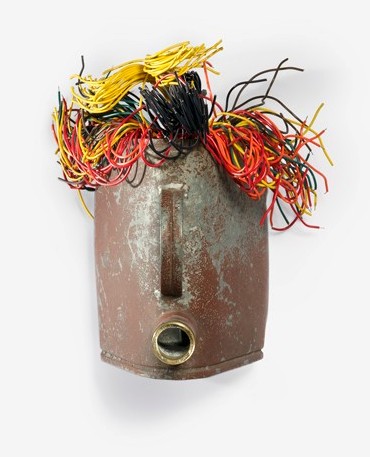 'Petrolheads', Pigozzi Collection
'Petrolheads', Pigozzi CollectionHere it was seen how a recycled object could have its inherent value consciously raised, by not only being a reflection of a production process but also, by having a political/social agenda attached to it; a concept, an idea to be communicated.
For more than 2 decades Hazoume's jerrycan masks have been telling their own stories, face-like forms that provide clues to the religious and political landscape of Benin.
Many other artists have followed Hazoume each making very personal statements both in design and form... and in critical comment.
Calixte Dakpogan is another artist hailing from Benin.
He currently lives and works in Porto Novo and much of his work is inspired by his Voudon heritage, more specifically his family affiliation with Ogun, the God of Iron. He transforms waste product and found materials in his wonderfully crazy, anthropological masks.
All manner of junk attracts his eye to create these very individualistic pieces... pencils, combs, car parts, cassettes, slops, anything he can collage together to form figurative works and abstract assemblages.
He considers his appropriation of these objects as a symbolic act of renewal and hope.
Joseph-Francis Sumegne, West Cameroon
Sumegne has been making intimate and detailed compositions for many years now and his pieces continue to grow in complexity of application. Not all of his components are found, some are appropriated for his vision... beads, braiding, hardware items, copper wire, scarves etc. He weaves, sews, braids and adheres, while also applying basket making and tapestry techniques to his art pieces.
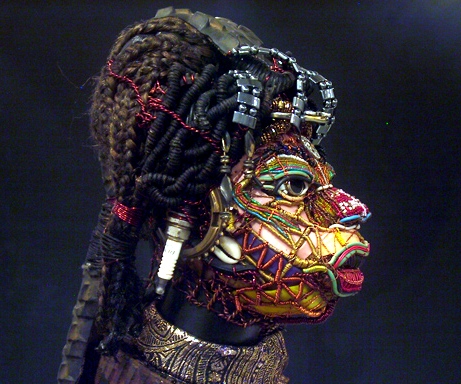 Sansage, Joseph Francis Sumegne, Doual' Art
Sansage, Joseph Francis Sumegne, Doual' ArtHis figures and his faces can take on a slightly menacing stance, they are bold and sometimes confrontational with strong identities and characteristics.
Kader Attia of France /Algeria embellishes traditional masks with new materials like mirror fragments, his idea being that the viewer will reflect on new thoughts about a traditional artifact.
And Pascale Marthine Tayou of Cameroon uses blown glass together with natural items and attached scraps of found pieces to produce a more ethereal-looking mask head.
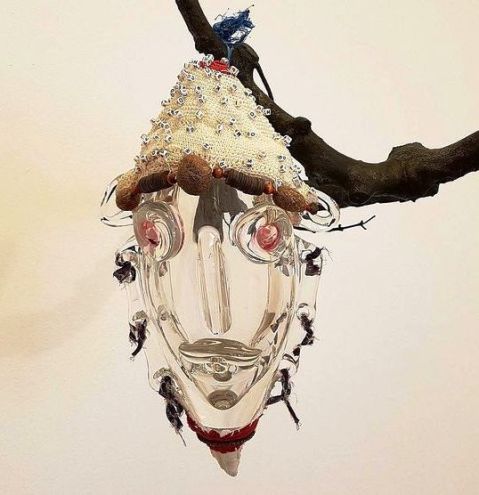 Pascale Marthine Tayou
Pascale Marthine TayouThere is no end to the choice of objects to recycle/reprocess or convert to something new.
Be it a sculpture, a mobile, a wall hanging, an item of furniture, a bag or a sheet of paper, a light, a piece of jewelry, a fashion item or even artwork reproduced on canvas. All are end articles re-purposed from discarded things.
Favored recycling materials come from vehicles, trains, engines, bicycles, skate boards, workshop tools, garage hardware, plumbing components, inner tyre-tubes, fuel and oil containers and electronic devices. Drinking cans and straws, food tins and cartons, fabric pieces, scissors, cotton reels, toys, plastic anything, kitchenware, glassware, pottery, tiles and mosaics, linoleum. Natural objects like bone, feathers, shells, quills, teeth and musical items like tapes, film, cassettes.. the list is inexhaustible!
Found objects are used just as they are or they can be altered and adapted to suit the artist's intentions. They can be cut up, broken down, broken apart, re-fashioned, stuck, glued, melted, welded, tied, hung, hooked, nailed... a multitude of applications that turn them into something else.
The following artists work with materials that may have been found in the first place but their work involves a more conscious and deliberate collecting or manufacturing more of the same to create their finished pieces.
The idea that there is a new language of art communicated by African artists who work in this genre is exciting; cultural inspiration melds with historical memories.
The found objects are the same as those distributed all over the world but the aesthetic responses and the technical application are African in context, creating transfigured art that reflects a continent's beliefs and society in a newly powerful way.
Moffat Takadiwa, Zimbabwe
Takadiwa's work is fabulous to behold.
Bold in presentation and resourceful in medium, he uses typewriter and keyboard pieces to create large wall sculptures that are highly inventive and original, forcing one to look closer to see what indeed his creations are made of.
Olu Amoda, Nigeria
Amoda is an internationally recognised sculptor, muralist, furniture designer and multi-media artist, always visible at major art fairs and attending workshops around the continent. He describes his art as "re-purposed material art'.
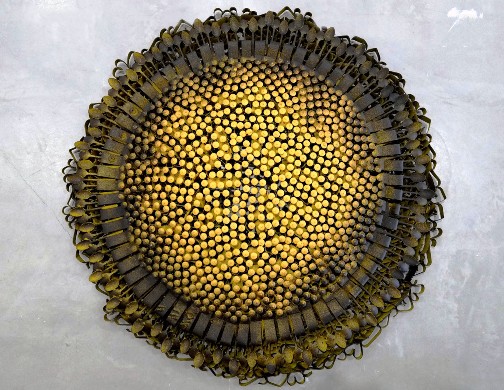 Olu Amoda, Sunflower2
Olu Amoda, Sunflower2In the series above he has used cutlery (spoons primarily) and other metal objects to create versions of sunflowers in a highly unusual and technically skillful manner. They are the perfect illustration of the transformation of inconspicuous materials to an object of beauty.
Roberto Vaccara, South Africa
Robert Vaccaro sculpts wildlife with metal found objects that can vary from a golf club to a can opener, to trumpets and bicycle components - all are welded together and embedded in an animals or human's body.
The final product is quite confrontational in appearance, starkly aggressive in reminding us that all scrap has a story; came from somewhere, discarded somehow... a history in fact.
Canvas and Paper
Benon Lutaaya, Uganda/SA
Lutaaya arrived in South Africa from Uganda in 2011 to take up his residency award at the Bag Factory Artist's Studio in Johannesburg.
Very quickly he realised 2 things; one, that he needed to do something outstandingly unique in order to be recognised and two, that art was a very expensive career in terms of procurement of materials to produce his work. He turned to collecting waste, specifically waste paper and began to create collages of torn, cut and creased paper, skilfully building up faces and figures into dynamic and invigorating portraits and half-torsos.
His pieces are sensitive in colour, application and content... often socially charged, they project human conditions and issues like poverty, immigration and political instability.
Mbongeni Buthelezi, SA
Buthelezi combines his artistic passion with a commitment to worldly environmental issues.
Once a cattle herder in Kwazulu-Natal, he has risen from his humble beginnings to become a much sought after artist. While studying at the Funda Centre for art in Soweto he started to collect plastic containers on the way to college.
25 years later he has perfected his initial technique into a real art form.
Molten plastic is applied to a canvas often in more than one layer to create complex textures and colour combinations. Each layer needs to be individually understood as different plastics adhere or melt in different ways. He can use about 5000 pieces of plastic for a single piece of artwork.
In addition to this form of application he draws in sepia and paints in colour and monochrome. This skill in drawing underwrites his collaged pieces and somehow, while the art pieces appear fragmented in nature, they still manage to hang together.
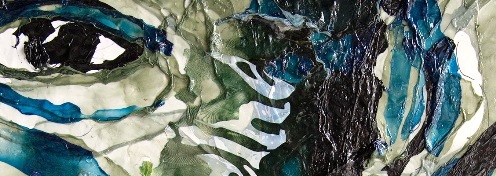 'Sugar tax' exhibition, Melrose Gallery, Jhbg, 2017
'Sugar tax' exhibition, Melrose Gallery, Jhbg, 2017His most recent exhibition is called 'Sugar Tax'. In this, he specifically uses plastic caps and soda bottles as his 'paint' to highlight the plight of obesity and diabetes, chronic health issues which plague Africa presently.
Duhirwe Rushemeza, Rwanda
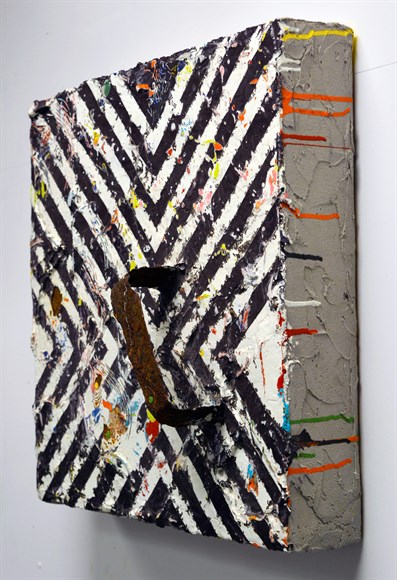 'Untitled'(Brown and White, Oxidized Handle)
'Untitled'(Brown and White, Oxidized Handle)In these paintings seen above, Rushemeza has used layers of thin-set mortar, concrete, acrylic house paint, wood and embedded metal detritus to create her artworks.
This assemblage process is deliberately left directly visible.... the artist builds up the layers only to sand and carve them away again revealing the painted patterns and the collected, 'found' objects. Her work pays homage to two disparate histories: the crumbling, colonial, Ghanaian and Ivory Coast buildings she visited in her youth and the rigid and graphically striking Imigongo paintings of SW Rwanda.
She paints this way to engage her viewers in topical subjects like human displacement, cultural adaptation and personal and material memories.
It would appear that no artist (and no viewer) can choose to engage with a piece of recycled or upcycled art of any form without undergoing recycling of their own memories, their own associations and their own views. Symbolic meanings are attached to any process whether physical or conceptual, sometimes it can be both in a single piece.
Therefore, a recycled piece can relate on very different levels to any one individual or group of individuals. Shapes recall other shapes, colours evoke other colours. Instinctively, memories are jogged and ideas are formed.... a piece is born again.
Street Art
This magnificent recycled sculpture is literally a traffic-stopper! Seen on the side of the road in Harare, Zimbabwe he just begs another up close look.
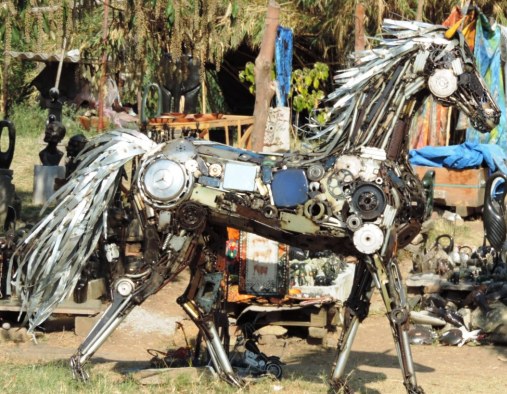 Recycled horse, Harare, artist unknown
Recycled horse, Harare, artist unknown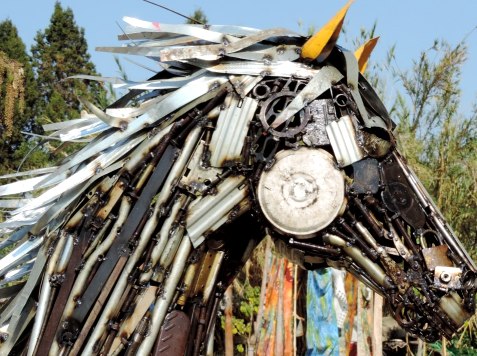
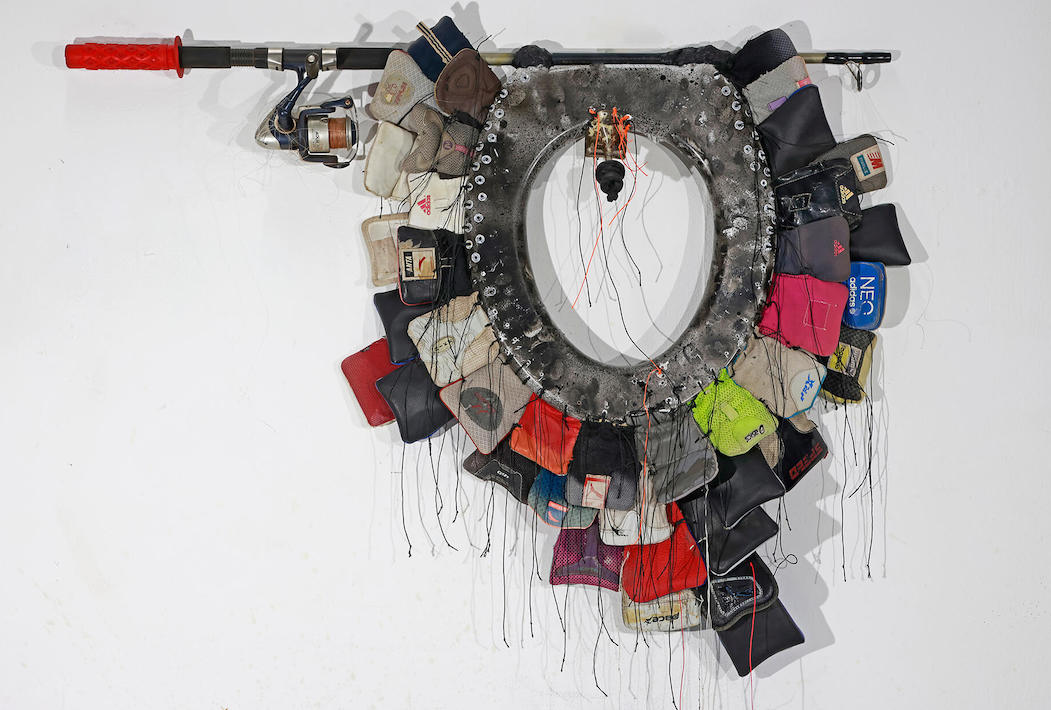
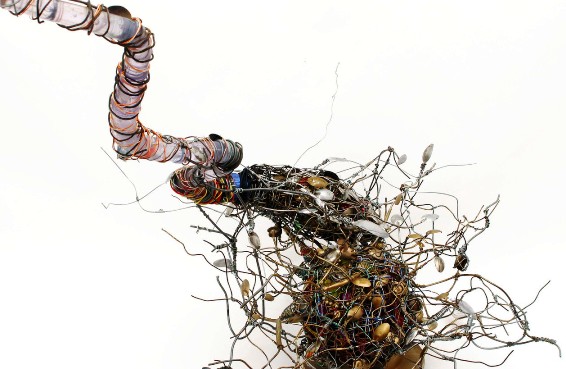
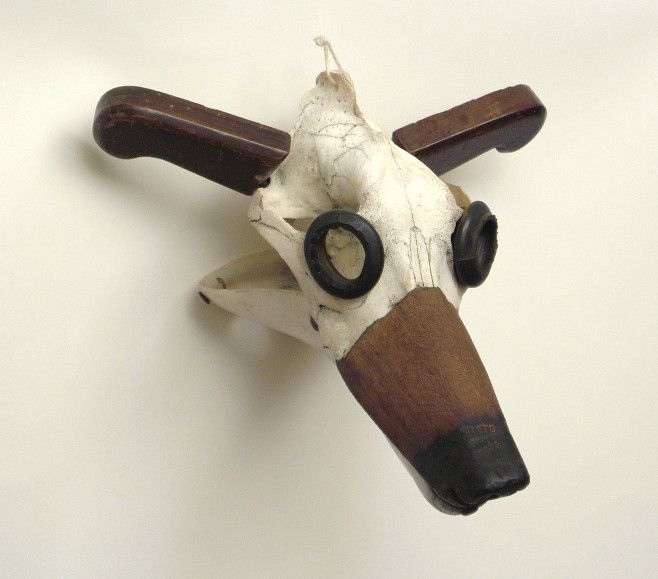
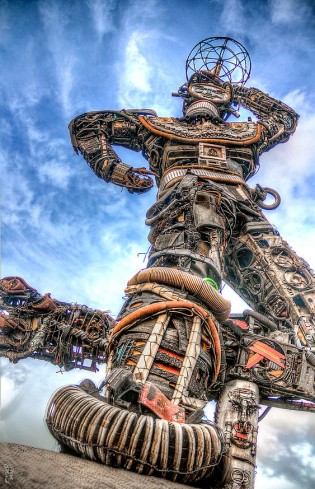
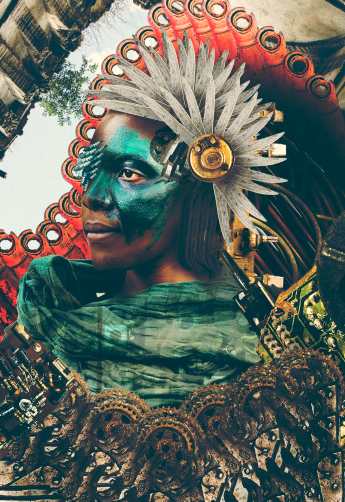
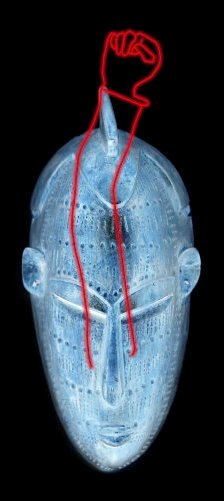
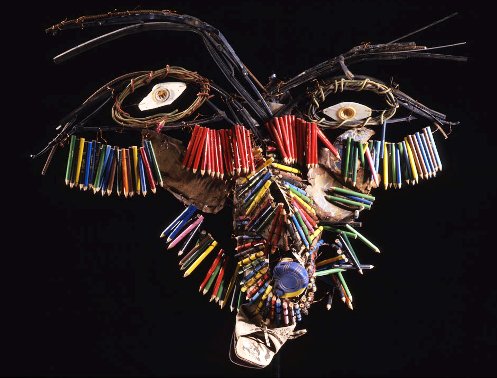
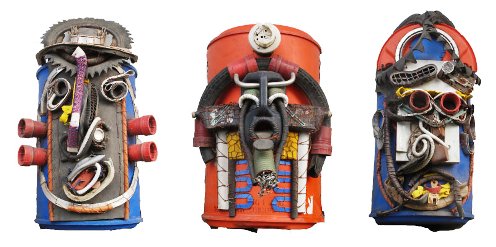
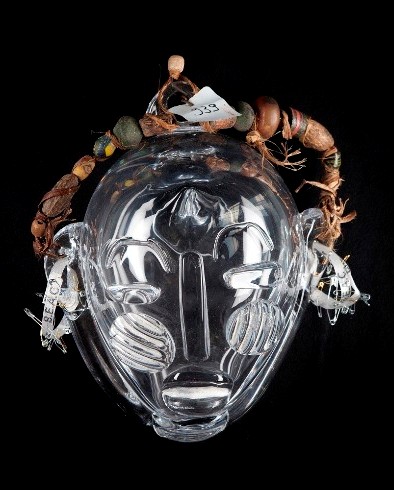
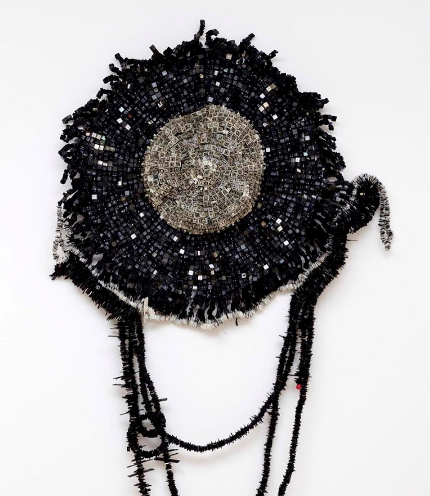
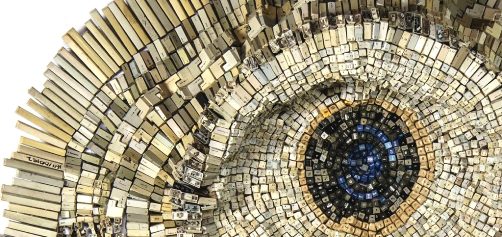
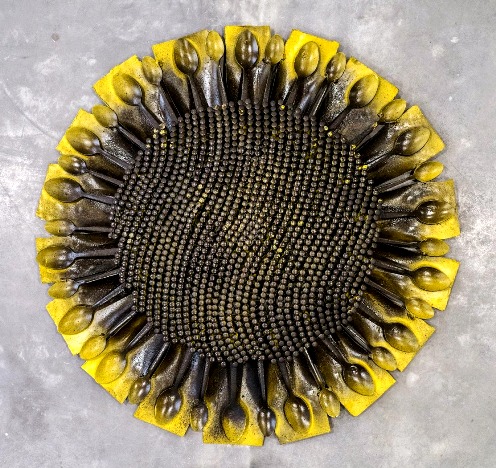
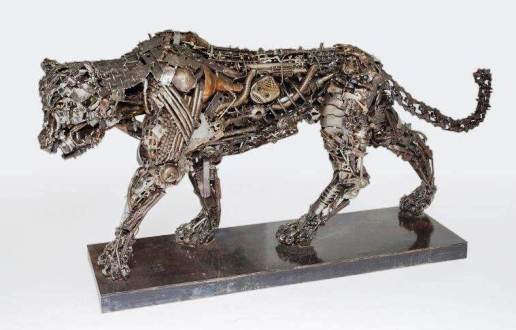
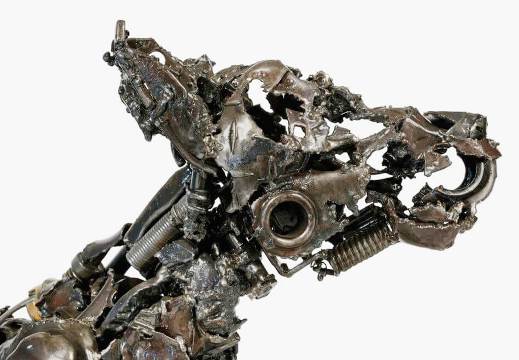
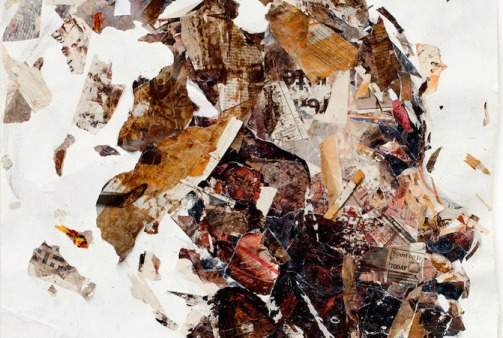
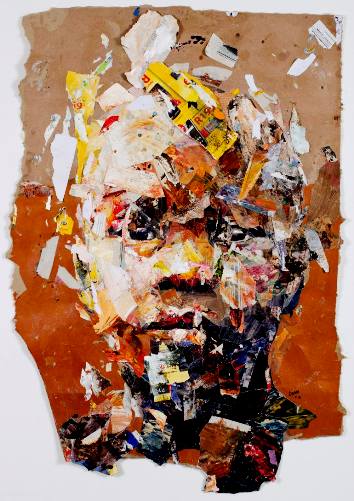
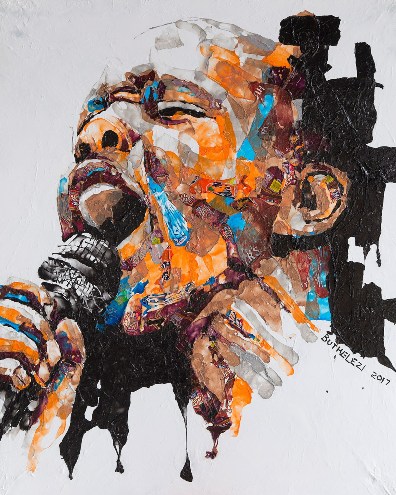
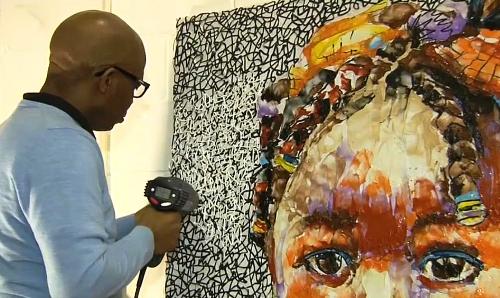
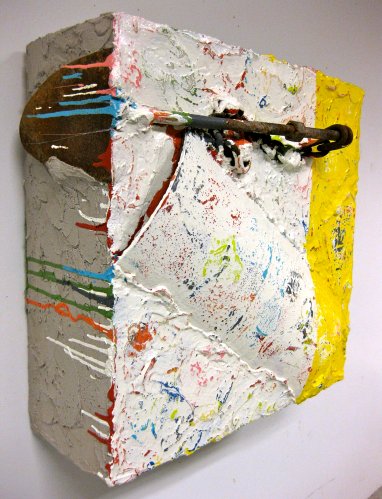
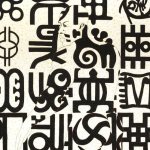
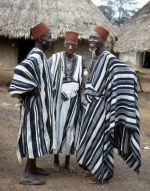
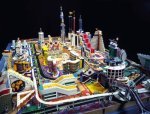
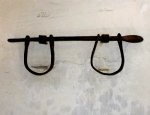
New! Comments
Have your say about what you just read! Leave me a comment in the box below.